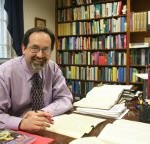The discussion which begins on p. 634 on how exactly Paul reformed and reaffirmed Jewish monotheism is interesting in various ways. Tom begins by discussing texts such as the cause celebre Rom.8.18-30. His translation of key phrases is interesting (on which see his earlier Romans commentary). Instead of the word predestined, he prefers ‘marked out in advance to be shaped according to the model of the image of the Son’. He also prefers the translation ‘called according to his purpose’ even though the word ‘his’ is nowhere in any Greek manuscript, and as Chrysostom says, the word itself can mean choice. Then one has to ask— Whose chose, God’s or the responders? This is indeed a viable question here because the ‘ous’ in vs. 29a has as its antecedent ‘those who love God’. In other words, the text reads ‘for those who love God, whom God foreknew, he also destined or marked out in advance. The discussion then is about the destiny of believers, not about how persons came to be believers in the first place. Their destiny is to be conformed to the image of the Son. And again, Paul is referring to a group of people— ‘those who love God, who were called according to choice/purpose’. Those folks whom God foreknew would love him (making clear that God’s choice was not mere fiat, or arbitrary but on the basis of God’s clear advance knowledge of how these people would respond). None of this is really dealt with at this juncture in the book, but we may hope for more later. Tom is certainly right here that we have a clear affirmation that the God who created it all is also the God who is in the process of recreating it all. This is an expression of creational monotheism, now reconfigured to include the Son and conformity to the Son’s image (p. 636).
But there are more implications to an affirmation of creational monotheism: “This positive view of creation also explains the passages where Paul indicates that, even among pagans, there is a moral sense which will recognize the good behavior of the Messiah’s people, and from which, in turn one can even learn by example. It is this too which enables Paul exactly in line with at least one regular second Temple viewpoint, to affirm the goodness and God-givenness of governments and authorities…even while reserving the right both to remind them of their God-given duty and to hold them to account in relation to it” (p. 639).
p. 640 finds Tom affirming an interesting connection— no idols also means there is only one true ‘image’ of God that has ever been on earth since the Fall, that is Jesus the Messiah, himself the truly human one. Those who are in the Messiah are to be renewed according to that image. What Tom does not say, but could have done is that this fits nicely with Paul’s contention that Christ is the last Adam, remembering that the first one was also created in the image of God.
On p. 644 Tom turns more specifically to the discussion of Jesus and monotheism. He is not happy with either the traditional liberal notion that high christology is late and therefore tells us nothing about the historical Jesus, nor is he simply happy with the attempts ala Hengel and company to demonstrate high Christology was thoroughly Jewish and early. He rejects the analysis of modernity saying “At the same time Romanticism constantly implyied that the ‘primitive’ form of any movement was the genuine,inspired article, the original vision which would fade over time as people moved from charisma to committees, from adoration to administration, from spontaneous and subversive spirituality to stable structures and a salaried sacerdotalism.” (p. 646). Nice turns of phrase, and there are many such in these volumes.
I found ironic Wright’s pronouncement on p. 647 that the work of Hengel, Bauckham, Hurtado makes it “almost inconceivable that one would go back to the old days of Bousset and Bultmann (or even Dunn, Casey, and Vermes).” (p. 647). Obviously, he was not aware that Bart Ehrman was about to launch yet another salvo based on such assumptions with a title something like How Jesus became the divine Son of God, or the like. Nonetheless, Tom is right that the idea that high Christology must be late has been so widely rejected that even Jewish scholars like Daniel Boyarin “have swung round in the opposite direction, arguing that most if not all of the elements of early Christology, not least the divinity of the expected Messiah, were in fact present within pre-Christian Judaism itself” (p. 648— see e.g. the recent flap over the Gabriel Stone). Wright’s judgment is that Boyarin has claimed much more than the early Jewish texts will support.
More importantly Wright is correct about noticing what Paul does NOT have to argue for— “”early Christians, already by the time of Paul, had articulated a belief in the ‘divinity’ of Jesus far more powerfully and indeed poetically than anyone had previously imagined. Paul can in fact assume his (very ‘high’) view of Jesus as a given. He never says, even to Corinth ‘How then can some of you be saying that Jesus was simply a wonderful human being and nothing more?’ Nor does christology seem to be a point of contention between him and (say) the church of Jerusalem. Despite regular assumptions and assertions, there is no historical evidence for an ‘early Jewish Christianity which (like the later Ebionites) denied identification between Jesus and Israel’s God.” (p. 648). Tom thus concludes that Paul’s view of Jesus couldn’t all have come from that revelatory moment on Damascus Road.
Thus the question remains, what pushed Jesus’ earliest followers after Easter in the direction of a high Christology. Tom is not satisfied with the older view that Jesus himself made such a thing possible and clear by the use of Son of Man language, thereby some kind of equality with Israel’s God, and that the early church saw the resurrection as the confirmation of Jesus’ claim. Tom oddly says about this view “I regard such a view as hopelessly short-circuited though not entirely misleading and mistaken” (p. 649). He does not explain what he means by short-circuited.
Tom is more impressed with the proposal of Larry Hurtado that “it was the sense and experience of the personal presence of the exalted Jesus, in the way that one might expect to experience the presence of the living God, that led Jesus’s earliest disciples first to worship him (without any sense of compromising monotheism) then to re-read Israel’s Scriptures in such a way as to discover him in passages which were about the one God”… In other words it was “‘early Christian experience’ of the risen lord in their midst that compelled them to the first stirrings of what would later becoming trinitarian and incarnational theology.” (p. 650). Wright things Hurtado is basically correct in his presentation and analysis of the phenomena and he sees it as completely ruling out the Bousset hypothesis (namely that when Christianity full engaged with the pagan world it absorbed pagan notions about deities and lords and applied them to Christ). In addition, Wright points to the recent work of Chris Tilling which demonstrates that Paul’s descriptions of the relationship between the early Christians and Jesus match the scriptural descriptions of the relationship between Israel and the one God (C. Tilling, Paul’s Divine Christology, Mohr, 2012). For example Paul’s passages about Christ being married to his believers (2 Cor. 11.2;Rom. 7.4-6, never mind Ephes. 5) relate directly to the OT theme of Israel being Yahweh’s bride.
But even beyond a basic agreement with Hurtado, Wright finds the proposals of Richard Bauckham even more important. The major point is that you can’t get to divine worship of Jesus as divine, from what is said in early Judaism about exalted angels or mediators. For example, notice the fierce rejection of the worship of an angel in Revelation coupled with the clear worship of God and the lamb. “Bauckham’s main proposal is that the NT, Paul included offered a christology of divine identity in which Jesus is included in the unique identity of this one God” (p. 651). So Bauckham stresses that identity concerns who God is, to be distinguished from ‘nature’ which concerns what God is. Thus he distinguishes what is going on in the NT from later debates about Jesus’ divine and human natures. (Bauckham notes however there is one exception to the rejection of the worship of intermediary figures— namely what is said about the Son of Man in the parables of Enoch).
Thus Bauckham concludes “the highest possible Christology– the inclusion of Jesus in the unique divine identity–was central to the faith of the early church even before any of the NT writings were written, since it occurs in all of them” (p. 652– quoted approvingly by Wright). Bauckham stresses there are three key aspects to Jewish monotheism– God is the sole creator, he will at last establish his kingdom, and he and he alone is to be worshipped. He then proceeds (in ‘God Crucified’) to demonstrate that in the NT Christ is portrayed as the agent of creation, the one through whom all things are reconciled and kingdom comes, and he is to be worshipped.
Tom’s own proposal is to build on Bauckham, but to add another component to eschatological monotheism, namely that the God who abandoned the Temple when it became corrupt, had also promised to return to Jerusalem and his Temple after the exile, come back to be king once more in Zion and set his people free from bondage. We will continue this discussion in the next blog post on this book.














